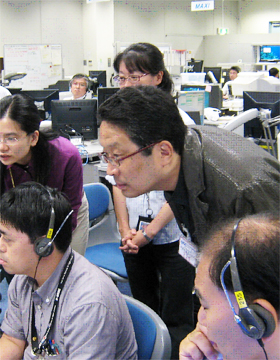This is an archive of information released in the past.
Disclaimer: It may contain broken links or outdated information. Some parts may not function in current web browsers.
*Visit https://humans-in-space.jaxa.jp/en/ for the latest information.

Experiment
- News
- Kibo Utilization Strategy
- Kibo Utilization Plan
- List of JAXA's Utilization Themes
- Experiment Facilities
- Space Environment Utilization
- Archive
Ferulate Experiment Begins
* All times are Japan Standard Time (JST)
Regulation by Gravity of Ferulate Formation in Cell Walls of Rice Seedlings (Ferulate)* began on board Kibo.
* Principal Investigator (PI): Kazuyuki Wakabayashi, Associate Professor of Graduate School of Science, Osaka City University
The Ferulate experiment uses the Cell Biology Experiment Facility (CBEF) in the Kibo Japanese experiment module.
Samples for the experiment were launched to the International Space Station (ISS) on the STS-132 mission (aboard the space shuttle Atlantis) on May 15, 2010.
The Ferulate experiment began at 5:55 p.m. on May 27, by commands from Tsukuba Space Center (TKSC).
Rice, corn, wheat are our essential food. Therefore, it is important for us to understand mechanisms of those plants, especially how cell walls of those plants support their bodies against the gravity force on Earth.
The plant cell wall is like a bone and muscle in animal body, and has many functions, such as supporting and standing upright their bodies against the gravitational force, protecting from pathogens and other predators, and transporting water and nutrients to each organ. The cell wall is an essential organ in plant.
The Ferulate experiment tries to examine levels of enzyme activities and gene expressions related to metabolisms of ferulic acid (FA) and diferulic acid (DFA), which play roles of "reinforcing structure" for the cell wall of gramineous plant.
The experiment uses caryopses of rice (Koshihikari). During launch, the caryopses in culture dishes are stored in low-temperature. Aboard the ISS, the culture dishes with caryopses are inserted into the CBEF, to let them germinate and grow for 4 to 6 days at optimal cultivation temperature. After that, samples on Day4 Day5 and Day6 are collected and frozen to be returned to the ground. Control experiments are also performed in the microgravity compartment and the 1G compartment of the CBEF using the same experiment procedures.
After the samples are returned to the ground, the team will analyze strength of cell wall structures, level of enzyme activities and gene expression that are related to the synthesis of DFA and FA.
Results of the experiment will provide useful data for plant breeding, such as creating a tougher rice strain by modifying and increasing the level of DFA and FA in cell walls. Also the results will provide basic information for designing a plant production system in space.
The experiment will be performed until June 2, 2010.
Special Message from Principal Investigator (PI)
The space shuttle was launched as scheduled. Caryopses samples, which we planted in the plastic culture dishes at Kennedy Space Center (KSC), were germinated in space just as expected. We began the experiment according to our original schedule. I hope that the rest of the protocol goes well in the same manner. I am grateful to the people who have supported our project.

Associate Professor Wakabayashi (center) monitoring
the experiment from the User Operations Area (UOA) at TKSC
*All times are Japan Standard Time (JST)
| Copyright 2007 Japan Aerospace Exploration Agency | Site Policy |